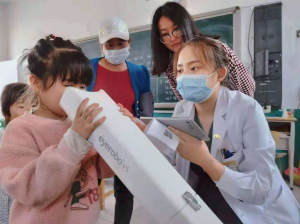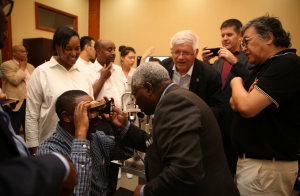Join a powerful, unprecedented alliance for better eye health for all.
Join IAPB-
Choose an alternate language here
Eye health has become a major public concern and an essential part of national health. In particular, the basic-level eye health screening has proven to be an effective way of preventing and treating blindness.
Rural doctors, the basic health service providers, are the main force in the development of rural medical and health services. The key to primary eye health lies in the following: empowering primary medical workers, setting up eye clinics in village and communities, as well as encouraging the primary health workers to participate in the construction of the eye health system.
 1 Apply the technology to the community eye health service:
1 Apply the technology to the community eye health service:
Constantly improving primary eye disease screening through software and hardware application.
To empower rural doctors from the bottom, medical hardware must satisfy three conditions. 1. Low price. 2. Easy to use. 3. Portable.
The iSpector mini portable slit lamp and kaleidos refractive screener currently adopted meet these requirements. Based on many cases and experience, these equipment are obviously effective in real screening activities. Regarding the software system, we have achieved all-around services including backend software, APP and WeChat official account. Thus, werovide professional services for different people and different demand sides.
The three-level prevention of blindness network of the He Group has currently provided basic eye care services to more than 100,000 people. These services include slit lamp examination, refractive examination and fundus examination. With the construction of the medical team at primary level, and dissemination of eye knowledge to the public, more and more population improve awareness of eye care and seize the best treatment timing.

Eye disease prevention and treatment as well as science popularization require the efforts of all ophthalmologists and health workers. Only in this way can we improve social awareness and gradually realize the mission of “A World without Blindness”.
眼健康作为国民健康的重要组成部分,已经成为公共卫生重大问题。
特别是基层眼健康筛查工作的开展,被证明是有效的防盲治盲的手
段。
乡村医生作为最基层的卫生服务人员,是发展农村医疗卫生事业的主
力军。为基层卫生人员赋能,把眼科医院开到卫生服务站、村口、社
区中去,动员最广大的基层卫生服务人员参与眼健康系统的建设,是
解决目前基层眼健康问题的关键所在。
1 科技下沉服务社区眼健康
从软硬件上持续赋能基层眼病筛查
要给基层的乡村医生赋能,硬件医疗器械必须满足三个条件。1.价格
低廉。2.使用简单。3.便携。目前我们采用的iSpector mini 便携式裂
隙灯和kaleidos 屈光筛查仪满足了这些要求。经过实地验证效果明显。
软件系统上,我们完成了从后台服务软件、智能手机APP 到微信公众
号的全方位服务,为不同人群,不同需求端提供了专业的服务。
2 构建眼病筛查三级医疗网
成绩斐然
目前建设的县乡村三级医疗网络,已经为10 余万基层百姓提供了基
础的眼保健服务。其中包括裂隙灯检查,屈光检查和眼底拍照检查,
覆盖了白内障、屈光、眼底病等大人群眼病的筛查。随着医疗队伍的
下沉,眼病科普同时推进,让更多处于基层的百姓能够了解具体是什
么眼病、危害和治疗手段。提供了更多的治疗机会。
该种基层筛查模式未来将陆续推广到埃塞俄比亚、乌干达、巴基斯坦、
柬埔寨、缅甸等国家,推动当地防盲治盲事业发展。
总结
眼病防治、科普工作需要所有眼科医生的努力,更需要所有卫生服务
人员的参与,只有这样,才能提高全社会对眼病防治的了解和重视,
实现“天下无盲”任重而道远。